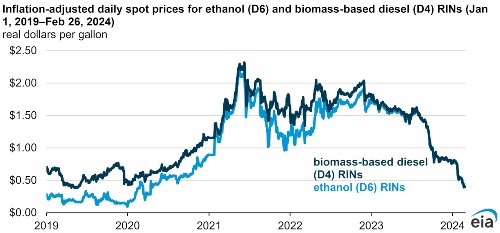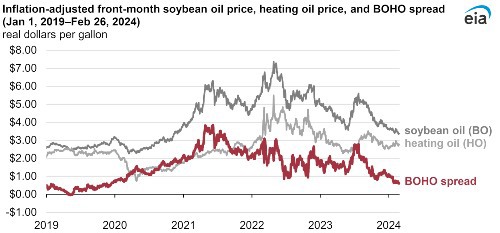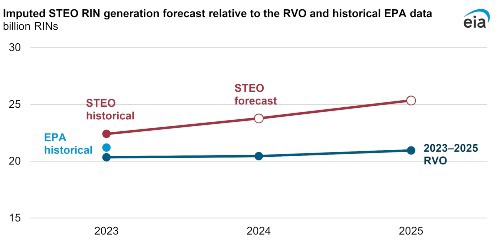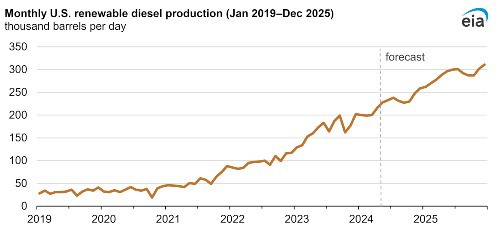Biomass-based diesel and ethanol compliance credit prices decline 45% from start of year

Data source: Oil Price Information Service and U.S. Bureau of Labor Statistics, Consumer Price Index
Note: RIN=renewable identification number. Real dollars are adjusted for inflation.
The price of compliance credits for biomass-based diesel and ethanol has decreased about 45% since the start of the year, when prices were already the lowest in about three years. The decline in the price of credits, known as renewable identification numbers (RINs), is due primarily to lower costs for agricultural feedstocks relative to petroleum fuels, and we expect prices to remain subdued due to record-high credit generation from the production of renewable diesel.
What are RINs?
RINs are credits used to comply with the Renewable Fuel Standard (RFS) program. Under the RFS, the U.S. Environmental Protection Agency (EPA) sets annual renewable volume obligations (RVOs) for the minimum volume of biofuels that must enter the U.S. fuel supply. Obligated parties—petroleum refiners and motor gasoline and diesel importers—comply either by blending biofuels into petroleum-based fuels or by purchasing RIN credits. Low RIN prices reduce RFS compliance costs for obligated parties. In addition, low RIN prices can decrease biofuel profit margins and, therefore, limit investments in future biofuel production capacity.
Ethanol production and imports generate D6 RINs that contribute to satisfying the total biofuel obligation. Renewable diesel and biodiesel production and imports generate D4 RINs. Under the fuel nesting scheme of the RFS, D4 RINs satisfy the biomass-based diesel (D4), the advanced biofuel (D5), and the total biofuel (D6) obligations. A gallon of ethanol generates 1.0 RINs, a gallon of biodiesel generates 1.5 RINs, and a gallon of renewable diesel can generate 1.6 RINs or 1.7 RINs, depending on its fuel pathway. Cellulosic RINs, known as D3 or D7 RINs, can also be generated, but they are not the focus of this analysis because their price trends tend to be independent of D4 and D6 RIN price trends.
What prices are RINs trading at?
As of February 26, D4 RINs traded at $0.41, and D6 RINs traded at $0.40; both credits are more than a dollar below their year-ago prices and their lowest since 2020. D4 and D6 RINs have traded at nearly identical prices to each other for about a year. Prior to 2023, however, D4 RINs traded with a larger premium to D6 RINs, mostly because of higher biomass-based diesel production costs, particularly in 2021 and 2022, and a greater biomass-based diesel blending obligation relative to existing production capacity.
The price of D6 RINs sets the price floor for D4 RINs because the RFS’s nesting structure counts D4 RINs toward the total biofuel requirement that drives D6 RIN prices. Since 2023, D4 RINs have mostly been trading near the price floor set by D6 RINs because D4 RIN generation has far exceeded the rates necessary to meet the D4 and D5 blending obligations. When this trend occurs, the total RVO drives the D4 RIN price.
Why are RIN prices decreasing?
The primary reason RIN prices have decreased so far this year is the 45% decline in the difference between soybean oil and heating oil prices, the Bean Oil-Heating Oil (BOHO) spread. Analysts track the BOHO spread because it reflects the economic viability of blending biofuels without federal policy incentives such as RIN credits and state policy incentives such as credits from California’s Low Carbon Fuel Standard. Typically, when the BOHO spread widens, RIN prices rise to compensate for relatively higher soybean prices reducing blending margins; when the BOHO spread contracts, RIN prices tend to fall because blenders require less incentive to blend.
Soybean oil serves as a reference point in the spread due to its widespread use as an agricultural feedstock for biodiesel and renewable diesel. In November 2023, soybean oil made up nearly 40% of the feedstock consumed for biomass-based diesels. Its price trends also tend to reflect those of other feedstocks such as tallow and used cooking oil. The heating oil futures contract is widely traded and serves as a benchmark price for U.S. diesel fuel.

Data source: Oil Price Information Service and U.S. Bureau of Labor Statistics, Consumer Price Index
Note: The Bean Oil-Heating Oil (BOHO) spread is the difference between the soybean oil and heating oil price. Real dollars are adjusted for inflation.
In February 2024, the BOHO spread contracted to its narrowest difference in about four years because of both lower soybean oil prices and relatively high heating oil prices. The price of soybean oil has decreased this year amid increasing global production and inventories. The U.S. Department of Agriculture (USDA) forecasts soybean oil prices will continue declining, as a result of decreasing demand in China, increasing inventories both in the United States and globally, and increasing soybean exports from Brazil. The price of heating oil has increased so far this year because of decreasing global diesel inventories, due partly to higher crude oil prices and refinery maintenance in Europe and on the U.S. Gulf Coast.
What’s the outlook for RIN prices?
RIN prices could remain low if U.S. biofuel consumption continues to grow, leading to more RINs than the RVO. The two sources of RIN supply are RINs generated in the present year and RINs carried over from the previous year. When the RIN supply is not on track to meet the RVO, which establishes the demand for RINs, RIN prices increase to encourage more biofuel production. Conversely, when the supply of RINs increases relative to the RVO, RIN prices fall.
Since the EPA set the 2023–25 biofuel blending targets on June 21, 2023, the supply of non-cellulosic RINs (all RINs not including cellulosic D3 and D7 RINs) has generally been on track to meet or exceed its targets. The EPA set the RVOs for non-cellulosic biofuels at 20.35 billion RINs in 2023, 20.45 billion RINs in 2024, and 20.95 billion RINs in 2025. In 2023, the number of newly generated RINs available for compliance slightly exceeded the 2023 RVO, according to our calculations based on EPA RIN generation data.

Data source: U.S. Environmental Protection Agency (EPA), Moderated Transaction System for EPA RIN generation data; Renewable Fuel Standard for RVOs; U.S. Energy Information Administration, Short-Term Energy Outlook (STEO) data browser based on February 2024 STEO forecasts
Note: Total RVO includes a supplemental standard of 0.25 billion RINs in 2023. We calculate historical RIN generation by taking EPA’s RIN generation data and subtracting the RINs the EPA reports as retired for exports or otherwise unavailable for compliance. The STEO does not account for renewable diesel exports, leading to a slight overestimation of RIN generation. RVO=renewable volume obligation, RINs=renewable identification numbers
Our latest Short-Term Energy Outlook (STEO) biofuel forecasts suggest that the RIN supply will continue to exceed its targets in 2024 and 2025. We can impute an EIA forecast for non-cellulosic RIN generation based on our STEO consumption forecasts for ethanol, renewable diesel, biodiesel, and other biofuels. Although our imputed RIN generation numbers overestimate RIN generation because we do not have renewable diesel export data, exports are unlikely to bring the number of RINs available for retirement below the RVO. If RIN generation exceeds 2024 and 2025 RVOs, RIN prices could decrease further.
Why do we forecast biofuel consumption to exceed the RVO?
We forecast biofuel consumption to exceed the RVO primarily because of growing domestic renewable diesel production. Renewable diesel is a transportation and heating fuel that is chemically equivalent to petroleum-based distillate fuel but is produced using fats, oils, or greases rather than petroleum. Renewable diesel consumption has grown in the United States because several federal and state government programs have created incentives to boost demand for the fuel.

Data source: U.S. Energy Information Administration, Short-Term Energy Outlook, February 2024
In response to those incentives, major oil companies have constructed renewable diesel production facilities, sometimes by converting former petroleum refining units. These new production facilities have helped renewable diesel production triple from 2021 to 2023.
We forecast renewable diesel production to continue rising in 2024 and 2025 as new production facilities open and capacity expansions are completed. Two major renewable diesel projects that we expect to boost production in 2024 are Marathon’s plant in Martinez, California, which expanded its production capacity in late 2023, and Phillips 66’s plant in Rodeo, California, which we expect to complete its full conversion to renewable diesel in the spring.
We forecast slightly slower growth in renewable diesel production in 2024 and 2025 than in 2023, however. This forecast largely stems from our assumption that renewable diesel production margins will decrease because of either lower RIN prices or a higher BOHO spread. We assume those lower margins will likely reduce plant utilization or lead to delays or cancellations of announced capacity additions.






Comments